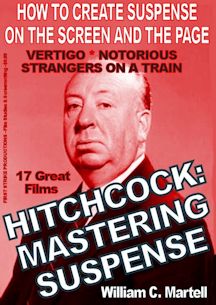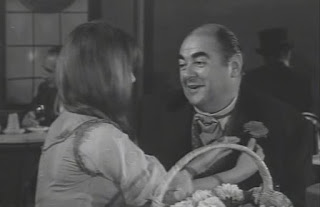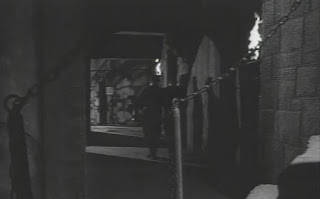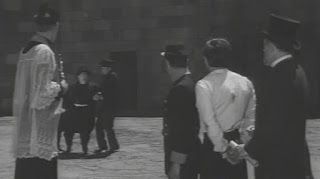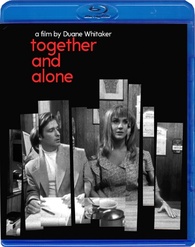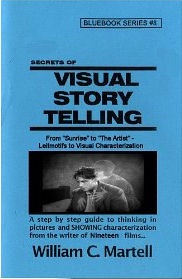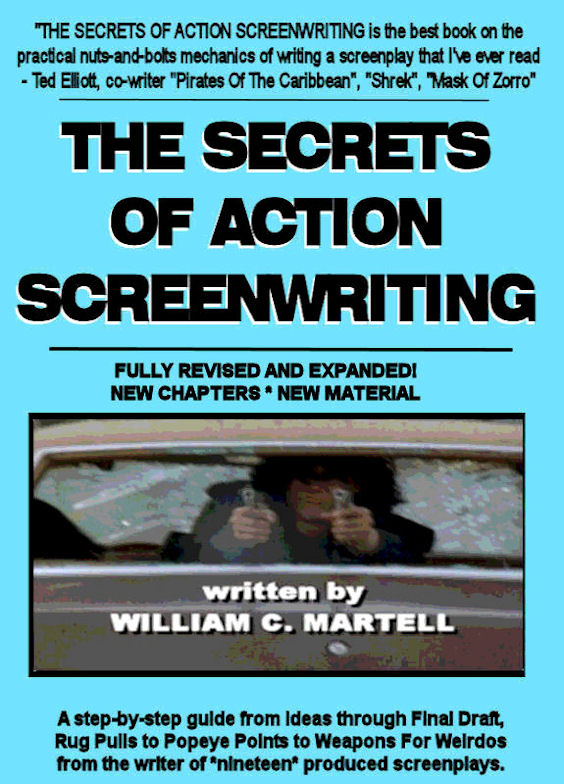Should have run this last week, because it's my favorite episode...
Guillotine
The spider web fills the screen, it's Boris Karloff's THRILLER!
Season: 2,
Episode: 2.
Airdate: Sep. 26, 1961
Director: Ida Lupino.
Writer: Charles Beaumont based on the story by Cornell Woolrich.
Cast: Robert Middleton, Danielle de Metz, Alejandro Rey.
Music: Jerry Goldsmith.
Cinematography: Benjamin Kline
Producer: William Frye.
Boris Karloff’s Introduction: “The early dawn. The gleaming knife. A man seized in his cell by armed guards in his stocking feet, snatched from a dream of freedom to be thrust into the waiting embrace of Madame Guillotine. Altogether an unenviable experience. Not however inevitable. It is related that there have been certain criminals, cutthroats and murderers all, who have by one means or another evaded this chilling fate. Well, the efforts of one such fellow to alter his ordained destiny form the substance of tonight’s story.
“The location: France. The year: 1875. And the theme? Well, you might call it togetherness. The normal association of a body and the head it comes with. You’re about to meet three people who enjoy seriously conflicting viewpoints on the subject. (The guillotine blade slices down, dropping a head into the basket which Karloff retrieves.) Here is the condemned man, Robert Lamont, who desires to keep his head while others about him are losing theirs. Enacted for us by Alejandro Rey. (The blade slices and the next head.) His good wife and the chief source from which his present dilemma obtains, Babette. Played by Danielle de Metz. (The blade slices and the next head.) And the third figure in this grisly triangle, the estimable and much maligned Mssr. De Paris. Public servant par excellence, portrayed by Robert Middleton.
“This drama may be considered, not to raise a tribute to the march of civilization, but also for the unconquerable spirit of convicted murderers. Of course, such practices may soon become things of the past. With modern methods of scientific liquidation instant death is now available to the masses without fuss and in most cases without undue delay. The old traditional ways were always so much more quaint.”
Synopsis: The Executioner “Mssr deParis” (Robert Middleton) tests the guillotine. They raise the blade, he locks the “trigger”, then pushes the lever with his foot to release the trigger. The blade glides down in a flash - through the neck stockade where a prisoner will soon be. The Executioner smiles. They place a cabbage in the neck piece and the Executioner pushes the trigger lever with his foot again. Wooosh! The cabbage is cleanly sliced in half. Half falls into the “head basket” below. The device is ready for it’s next victim...
Hours before dawn: In the darkest cells of the prison, two Guards have removed their shoes and creep to a cell where two condemned men sleep. Professional gambler Robert (Alejandro Rey) wakes up when the cell door opens. Are they coming for him? No, the Guards grab the other prisoner, who screams for his life. Robert watches through the cell door as they take him away...
Just before dawn: The cell door opens again and Robert turns - are they coming for him as well? No, it is his wife Babette (Danielle de Metz) who has bribed a guard for this visit. We get a nice piece of dramatic exposition on how he got to this place: he discovered Babette was cheating on him and killed the man. He claims he has forgiven Babette, but seems to rub in her indiscretion again and again, which makes her attempts at last minute reconciliation difficult. He kisses her and tells her that he has forgiven her, but can not forget. That her testimony against him may have damned him to this fate, but he knew they would force her to take the witness stand. That any other jury would have come back with a “not guilty” verdict, because of the “unwritten law”. There is all kinds of baggage in this relationship - and love and anger are in equal parts.

Cheering from outside the cell, and Robert and Babette look out the window to see the prisoner being escorted to the guillotine. Woosh! Plop - the head falls into the basket.
Robert tells her that soon it will be his turn, and Babette asks what can she do? Robert tells her that tradition, an unwritten law, that if the Executioner dies on the day of an execution the condemned man is set free. So if she can find out what day Robert is to be killed, and then kill the executioner... they can be together again. Babette isn’t all that hot on killing a man... will she do it or not?
The Executioner is given his next assignment from the warden... Robert. The clock is tricking... but ticking until *when*?
A Few Days Before The Execution: Outside a café, Babette carries a basket of flowers, selling boutonaires... and approaches Executioner. He is amazed by the bright colors of her carnations, and asks where she buys her flowers. She says she grows them herself, this is a family flower that has been in her family for generations. The Executioner’s hobby is gardening, and he asks her to sit with him for a moment and discuss flowers. She flirts with him as they discuss flowers - and there’s no shortage of words and phrases with double meanings here. He is a lonely older man, a sad man, and she is a beautiful woman. She offers him clippings of her family’s carnations... and asks when she can come by with them... cleverly finding out that he must get up very early on Thursday to work. So they make a date for Wednesday afternoon.
After he leaves, Babette accepts a drink from one of the other customers - a carriage Cab Driver (Gaylord Cavallaro) who informs her that man she was talking to was the Executioner. The most hated man in Paris. This is more sly exposition, as this guy is trying to pick her up by giving her some information... including that the Executioner will cut off a man’s head for money, but he wouldn’t hurt a cockroach without being paid...
This episode is filled with great matchcuts, and on the word “cockroach” we go from an empty saucer in the café to an identical saucer in Babette’s flat with a cockroach eating some poison on it and keeling over onto its back - legs convulsing. Babette is timing the roach’s death as she brushes her hair. She pours the poison into an ornate little tin, wraps it in her lace handkerchief and...
The Day Before The Execution: Her lace handkerchief on her lap as she sits in the Executioner’s garden on Wednesday afternoon. He plants the clippings while she flirts with him. When he’s finished he sits with her and breaks the bad news that he knows will break his own heart - he tells her that he is the city’s executioner. But she doesn’t seem to be repulsed like everyone else... like every other woman he has ever met in his life. “I am not under sentence, Mssr. And until I am, I don’t see why I should fear you.” Wait... is this a chance for the executioner to find love? Romance? This young woman knows his secret and continues to flirt with him.
This is a great scene, because she is flirting with the man who will take off her husband’s head... unless she poisons him dead. And he is a charming, shy, sympathetic man... who dislikes his job, but someone must do it.
They are close to kissing when they’re interrupted by his housekeeper Mdm LeClerc (Janine Grandel), who is calling him to dinner. The housekeeper is stern, abrasive, and reminiscent of Danvers from Hitchcock’s REBECCA. Oh, and slightly jealous. She tells Babette that she must leave now. Babette grips the lace handkerchief with the poison cannister as he walks her to the front gate. How will she poison him now? She offers to take a stroll with him later that night, but he says he must get up very early for work tomorrow. She says his dinner smells delicious and he gets the hint and asks her to dine with him.
Dinner for three. No shortage of tension as Mdm LeClerc snipes at her the whole time... while Babette tries to figure out some way to drop her poison into his food while the housekeeper isn’t looking. Had it just been the two of them dining, it would have been much easier. His wine glass is right there... but the housekeeper is watching her like a hawk. The tin of poison stays wrapped in the lace handkerchief.
After dinner, the Housekeeper steps into the kitchen for a moment and Babette asks the Executioner for a glass of water as a way to distract him so that she can pour the poison into his brandy snifter. But the moment his back is turned for a moment and the tin is out of her lace handkerchief the Housekeeper returns. Dinner is over, time for her to leave... and she still hasn’t poisoned him!
Time is ticking away until dawn and the execution!
The Housekeeper mentions that she is preparing the Executioner’s favorite breakfast for his pre-dawn breakfast - apple pancakes (pastry). Babette asks Mdm LeClerc if she will show her how they are made, and the two women go into the kitchen. On the counter is a big bowl of chopped and seasoned apples next to the dough. Babette asks her to write down the recipe, and while Mdm LeClerc is doing this she dumps the tin of poison into the apple mixture and quickly stirs it. The poison looks like the cinnamon. Babette quickly sets the stirring spoon down as the housekeeper hands her a folded piece of paper with the recipe.
In the prison, a guard slides a folded piece of paper to Robert. A note from Babette saying that he need not fear the dawn, she has completed her assignment.
The Morning Of The Execution: The Executioner’s Assistant (Peter Brocco) preps the bladeless guillotine for Robert’s execution.
The two Guards take off their shoes and creep to a cell where condemned men sleep... this time they have come for Robert. The Warden (Gregory Morton) enters with a Priest (Guy deVestel) for Robert’s final confession. Robert apologizes for getting the Priest up so early in the morning, but he has nothing to confess.
The Executioner finishes a big plate of his favorite breakfast, the apple (poisoned) pancakes. Checks his watch - time to go. Grabs the guillotine blade in it’s leather carrying case and checks the blade - very sharp. Puts on his coat and leaves the house - briskly walking across town in the pre-dawn light.
In the pre-dawn light the Warden and Priest and Guards escort Robert through the prison hallways to his death. Robert continues to turn down the Priest - if he dies without final confession he will be sent to Hell. Robert wonders why everyone is so sure that he will die today, and makes a 2 to 1 bet with the Warden that he will live to see the sun set again.
The Executioner continues briskly walking across town - almost marching - to Robert’s execution. But he halfway down this street he stops for a moment, removes his handkerchief and wipes sweat from his brow. Is the poison finally taking effect? Or is it just a warm morning? He checks his watch...
The Executioner’s Assistant checks his watch - the Executioner is running a little late this morning, but there is still plenty of time.
The Warden and Guards escort Robert downstairs, Robert almost tripping at one point. “Watch your step, Mssr.”
The Executioner almost trips... he is now feeling sick. He holds his stomach, has to stop for a moment to wipe the sweat again. Passes a bar with a sign advertising Cognac...
The Warden pours Robert a snifter of Cognac, and one for himself - the condemned man’s final drink. A philosophical conversation... then Robert asks if it is true that if the Executioner dies on the day of the execution the next man in line is pardoned? Yes... but this Executioner has never been late, never been ill... never had so much as a stomach ache.
The Executioner holds his stomach, leaning over a fountain - sick. He staggers down the street, face sweating, sees a pharmacy and pounds on the doors. No one answers - it’s before dawn. He continues staggering forward, hanging onto the pillars of a building to stay upright. Marching forward to Robert’s execution, the case with the guillotine blade at his side. He passes a barber shop...
The Barber (scene stealer Marcel Hillaire) arrives to shave Robert and cut his hair - must look good for his execution, right? A very macabre conversation between the two: they talk of going to Hell, and the Barber says it is a myth that he draws the line on the neck for the Executioner to follow, and he has never loaned his razor to a prisoner so that he wouldn’t have to face the national blade... all myths.
The Executioner continues forward in agony. He *will* make it to the execution. Nothing can stop him... even though he is sweating like a horse.
A sweaty horse and the cab behind it stops at the prison’s side gate. The Cab Driver helps Babette down from the carriage, joking with her about being front row for the execution. Flirting with her in an odd way. She shoots him down, he drives away. Babette asks the Gate Guard if she can enter here to see the execution. Nope - this gate is only for the Executioner. The public gate is around the corner. Has the Executioner arrived yet? Not yet. She smiles.
The Warden tells Robert that the Executioner is here, now, testing the machine. He has never been late. “I can assure you that at this very moment he is raising his hand in a signal to his assistants.” For the first time Robert looks worried.

The Executioner raises his hand to hail the taxicab as it comes towards him. The Cab Driver stops, climbs down to where the Executioner is doubled over in agony. “Something I ate...” The Cab Driver offers to take him to a doctor, but the Executioner says he *must* get to the prison to fulfill his duty. The Cab Driver says he will take the man to a doctor because that is the right thing to do, but he will *not* take him to the prison to take another man’s life. One of the great things about this episode is that it manages to keep you on the edge of your seat while discussing capital punishment. If the Cab Driver takes the Executioner to the prison, Robert dies. If he refuses, Robert has a chance at living. So the stakes in this conversation are the stakes in the story. And it’s dramatic, because the Executioner is seriously ill... but still arguing that he must do his sworn duty. And the great side-effect of budget constraints in television is that this is the same Cab Driver from the café, the same one who just took Babette to the prison and was on his way back from the prison when the Executioner flagged him down. So we *know* this character. His earlier conversation with Babette about how the Executioner wouldn’t kill a cockroach but sees nothing wrong with killing a man tints this conversation. The Cab Driver tells him that his conscience will not permit him to take him to the prison, but it is only a few hundred yards away, and drives off.
The Executioner continues staggering towards the prison... towards Robert’s death.
Ten Minutes Before The Execution: The Assistant tells the Warden that the Executioner has not arrived yet, not even a message from him. There will not be time for a test before the execution. Robert is no longer worried... the Warden is worried.
The Executioner staggers relentlessly towards the prison - it is within sight now. He leans up against a wall, sick. A Policeman approaches, thinks he’s a drunk, tells him he should go home and sleep it off. The Executioner says he *must* get to the prison... then keels over.
Robert and the Warden have a conversation about execution versus rehabilitation - again, this is perfectly in context for the story and even adds to the suspense because the longer they stall the execution the more likely that the Executioner will finally stagger into the prison with the guillotine blade and Robert will lose his head. Robert - the gambler - asks if he shouldn’t be taken to the execution platform about now. Hey, the spectators must be disappointed. The Warden has Robert taken out to the courtyard, knowing that if the Executioner doesn’t show up it will be a major public embarrassment for him.
That Policeman wants to get the Executioner to a doctor, but he *must do his duty*... so the Policeman helps him to the prison.
They bring Robert out to the courtyard - the spectators go wild. Robert looks through the crowd for Babette - can’t see her. The Priest makes one final effort to get Robert’s confession, but he refuses. Minutes tick away - if they get to the time of the execution and the Executioner has not arrived, Robert goes free.
Babette is not in the crowd because she is still at the prison’s side gate - counting down the minutes there, worried that the Executioner still may arrive. He is a big man, did she put enough poison in his food for such a big man? What if he is *not* dead? What if he is still coming to the execution?

And then the Executioner appears across the street, held up by the Policeman (Vance Howard, Opie’s dad). The Policeman yells for the Gate Guard to give him a hand. Babette backs up, hiding in the doorway. Terrified that the Executioner will fulfill his duties. The Policeman and Gate Guard practically carry the Executioner to the gate, leaning him against the wall only inches from Babette as they open the door. The Executioner looks right at her and asks, “Why?” She tries to get away from him, but is trapped in the doorway - trapped with the man she murdered. A shy and lonely man... now close to death. “I thought you were fond of me. For the first time in my life someone who... Why?” Big dramatic moment. Babette says she has never seen him before in her life and walks away.
The Executioner tells the Policeman to stop her, and she is taken into custody. The Executioner tells her that he *will* keep his appointment, and there’s an echo here of her earlier line about not having to fear him because she is not under sentence. Well, she will be now!
The Executioner’s Assistant and the Prison Doctor (Charles LaTorre) come out, and they take the Executioner into the courtyard... and the guillotine... and Robert.
Robert is preparing for victory, when the Executioner is carried into the courtyard. The spectators cheer - the show will not be cancelled! Robert realizes this can go either way - his confidence vanishes.
The Executioner falls to the ground. The Assistant takes the case with the guillotine blade from him and attaches the blade. They help the Executioner to his feet.
Robert says, “He will never make it,” but he’s not sure he believes that.
The Executioner’s legs no longer can hold up his stout body, but they carry him towards the platform... closer... closer... closer! Robert repeating, “He’ll never make it!” with less confidence with every foot closer to the platform.
Robert is taken up to the guillotine, his neck placed in the stockade, his head dangling over the head basket. He yells that no one but the Executioner must touch the trigger.
Only the Executioner and the Prisoner are allowed on the platform, so they lay the Executioner down at the base of the steps.
“No one else! You hear me, no one else!” Robert is screaming and crying and...
The Executioner is *crawling* slowly up the stairs to the platform. Each step is agony.
The spectators are screaming.
Robert is screaming.
The Executioner is slowly crawling across the platform to the guillotine. One inch at a time. Closer... closer... closer.
Robert is screaming, “He can’t kill me! He can’t kill me!”
The Executioner crawls right up to the guillotine trigger! And then drops to the platform - unmoving.
Robert’s screaming turns from terror to hope.
The Prison Doctor climbs up onto the platform, holds up the Executioner’s arm to take his pulse. Conforms that he is dead.
Robert’s hope turns to triumph, to joy - he will be set free! “He’s dead! I win! I win! I win!”
The Prison Doctor lets go of the Executioner’s wrist... and his arm falls... and hits the trigger... and the blade falls... and so does Robert’s head.
The end.
Review: Another perfect storm for me - Ida Lupino *and* Cornell Woolrich! When I first watched the THRILLER show as a kid, this is the episode that stuck with me. It had me on the edge of my seat for a full hour. Would the executioner make it to the prison? I was a little concerned when watching it again that it wouldn’t hold up to my memories... but it was just as great as I remembered it.
As I’ve said before, Woolrich is known as one of the three fathers of modern Noir fiction, and the films made from the work of those three and their contemporaries are what we know as Film Noir. Woolrich is the guy who put the Noir in Noir thanks to his “Black Series” of novels, including BRIDE WORE BLACK, BLACK PATH OF FEAR, BLACK ANGEL, and many others. And if you are wondering how Noir can have three fathers and no mothers, Woolrich is probably closest to taking that mother role... not because he was Gay, but because he specialized in female lead stories. Noir from the woman’s point of view. Many of his stories, including this one, deal with women doing terrible things to save the men in their lives. Since Noir is about good people doing bad things... and discovering the darkness within that they wish they’d never uncovered, the idea of an “innocent” housewife stepping over the line to help her husband out of a jam is prime Noir territory and Woolrich mined it throughout his career.

I have always wanted to do a more faithful film adaptation of his novel BLACK ANGEL about a basically quiet and subservient suburban housewife whose husband is accused of murder and there is so much evidence that he *will* be convicted... so comes out of her shell and becomes a detective, going undercover to trace his steps on the days leading up to the murder in order to uncover the real killer. But this quest creates one line after another that she must cross - creating a spiral of descent into the darkness. How far will she go? Will she start using drugs in order to be accepted by addicts as she goes undercover following a lead? Yes! Will she become a prostitute and sleep with a bunch of strange men in order to follow a lead? Yes! As the quiet housewife spirals down and down in search of the evidence to clear her husband of these charges - degrading herself again and again - we begin to wonder if this man is worth all of this. If *anyone* is worth all of this. And also - if she proves him innocent, will he want whatever is left of her back? This is an awesome Noir story that Hollywood cleaned up for film - robbing it of all of its darkness. In the novel she proves that he is innocent and they live happily ever after... but Woolrich, like Raymond Chandler and many other pulp writers of the time, based his novels on short story material he’d previously had published... and in the short story version, “Angel Face”, she degrades herself only to discover that her husband is guilty, was always guilty, and their whole marriage was based on her believing his lies. And that’s the Noir ending I would use on a new film version. Darker than dark.
A similar ending to this story GUILLOTINE - where our wife character Babette must seduce and murder the executioner in order to save her husband’s life... and after she does all of these terrible things, it ends up being all for nothing. How dark can you get?

Though this is a fairly simple story - will Babette be able to poison the Executioner for the first half and then will the Executioner make it to the execution for the second half - it is all about suspense. Both of those situations are focused on suspense and the episode (and Lupino’s direction) are relentless in keeping us on the edge of our seats in anticipation. This is another Woolrich trait - where Hitchcock was the master of suspense on screen, Woolrich was the master of suspense on the page. Where they two intersect - the movie REAR WINDOW and the TV episode 4 O’CLOCK - we end up with classics. Woolrich knew how to keep the suspense escalating on the page, and in his novel PHANTOM LADY (which also needs a more faithful remake) the chapter titles tell us how many days until the protagonist will be executed for a murder he did not commit - even before the murder has occurred in the story! Talk about a page turner! You can’t finish one chapter without seeing the title of the next chapter with the number of days left... and you end up continuing to read. Can’t put it down! This episode uses those same suspense tools. We know when Robert will be executed and count down the days, hours, minutes, seconds until that happens.

One of the reasons why the suspense works in this episode is what I call the “THUNDERBALL Theory” in my Secrets Of Action Screenwriting book. In the James Bond movie THUNDERBALL the villain Largo has *two* nuclear weapons, and “tests” one on an island before hiding the other somewhere in Miami. That way the audience can see the destruction this weapon causes so that they know what would happen if the one in Miami detonates. If the audience doesn’t understand what will happen, if it remains abstract, there is less suspense generated. In GUILLOTINE we open with the title device being tested so that we understand what will happen later if Robert’s neck ends up meeting that hurtling blade. We get some great visual exposition showing us step-by-step how the device works - including that trigger which will become very important at the very end of the episode where there is no time to explain anything. You always want to get exposition up front so that it doesn’t get int the way of the ending. We don’t want to be explaining how that trigger works moments before the Executioner’s arm drops on it! Plus, knowing the full scope of the “event” gives the anticipation of that event (suspense) more weight. It’s not an abstract concept, this execution by guillotine, we have seen what that blade can do to a cabbage. And they *do* use this blade on the necks of men - which we know because that test at the beginning of the episode is for Robert’s cellmate... who loses his head soon after that test.
Hey, that brings up another great storytelling tool used in this episode - repeating the events that lead up to the execution. The episode opens with the Guards taking off their shoes and sneaking up to the death row cell to take the next victim of the guillotine... and grabbing Robert’s cellmate. By showing this procedure early in the episode, when we see the same procedure happening again we *know* that Robert will suffer the same fate. It makes the execution *real* and amps up the suspense in the situation. It’s a cousin to the THUNDDERBALL Theory - by showing what happens early, we turn an abstract idea into something tangible and that creates suspense later. This isn’t just some vague idea of a bad thing that might happen, we’ve *seen it happen*.

But the key to this episode and the key to this being effective as Noir is Robert Middleton’s performance and the way his character is portrayed. The Executioner must be both a serious threat *and* a sympathetic victim. Simultaneously. That’s a tough thing to pull off for a writer and a director and an actor - and here all three manage to walk that razor’s edge without being cut. Middleton, a character actor probably best known for the brutish escaped convict in DESPERATE HOURS, probably does his best work in this episode. When his blurry vision clears for a moment at the prison doors and he recognizes Babette, we genuinely feel for him. “Why? I thought you were fond of me. For the first time in my life someone who... Why?” That’s a heartbreaker!
The amazing thing this episode does is make up both want the Executioner to succeed in getting to the prison to do his job, and *not* make it to the prison so that Robert won’t lose his head. Ida Lupino manages to pull that off (with the help of Middleton and TWILIGHT ZONE screenwriter Beaumont - 22 episodes!) masterfully. Lupino is one of those great directors who somehow has slipped through the cracks and is not studied today. Part of that may be because she had to fight for every credit and ended up directing a bunch of silly TV shows like GILLIGAN’S ISLAND, but her work was always imaginative and amazing. Here she gives us POV shots from the Executioner that replicate the blurry fever vision of a poisoned man. Her THRILLER episodes and films are often filled with amazing visual experiments (frequently mentioned in this series), but she also knows exactly how to create suspense through editing and angle and camera movement. Her film THE HITCHHIKER is edge of the seat suspense. Here we have a simple story which is just a guy walking to work, right? Some other director might have made it just as exciting as some guy walking to work, but Lupino turns out an episode that was my favorite as a kid and still holds up as an adult.

Oh, gotta mention the amazing Jerry Goldsmith score! One of the major components in creating the suspense in this episode is his relentless score makes us feel the determination of the Executioner. Goldsmith was my favorite composer of film music from my lifetime, and long before he became one of cinema’s greatest composers of the 70s and 80s, he cut his teeth doing weekly scores for TV shows like THRILLER. His music elevates many of the weaker episodes and turns great ones like this into classics.
Okay, I’ve probably oversold this episode, but it’s still my favorite after all of these years and Stephen King and his PIGEONS FROM HELL can go suck it. Next week the streak of good episodes continues with an adaptation of Poe’s THE PREMATURE BURIAL, and after that another great creepy episode based on Robert Bloch’s THE WEIRD TAILOR. Stay tuned!
- Bill


